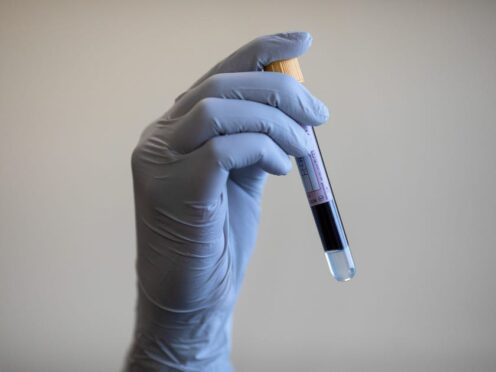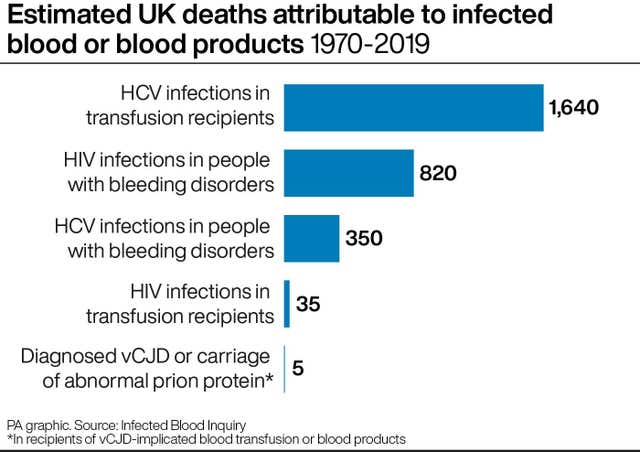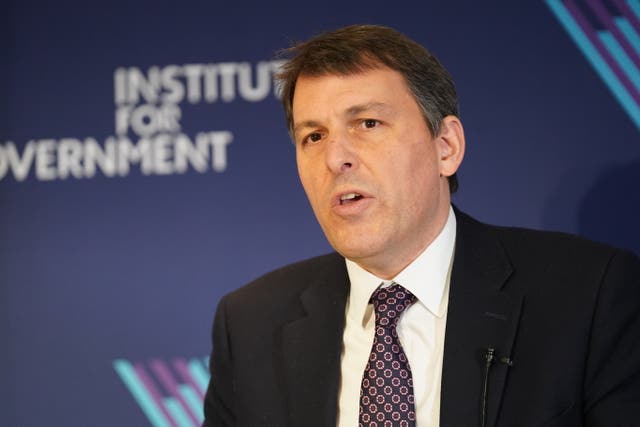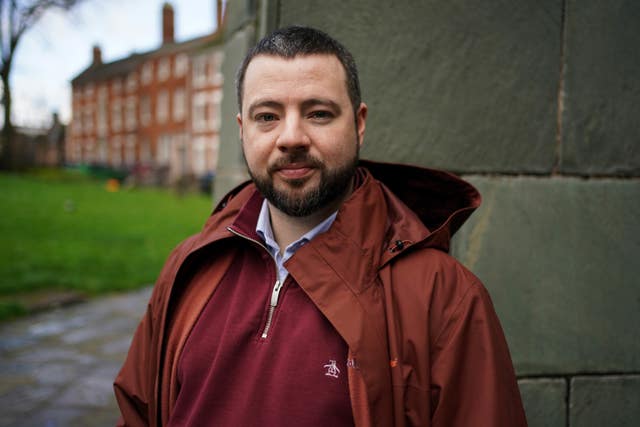
The Government has announced a compensation scheme for people who contracted deadly viruses through contaminated blood or blood products.
Here the PA news agency answers questions on what we know so far.
– Why are people getting compensation?
More than 30,000 people who received NHS treatment between the 1970s and early 1990s were infected with contaminated blood.
They contracted a number of viruses including hepatitis C and HIV.
Some 3,000 are dead as a result and survivors are living with life-long health implications.

– What has the Government said?
The Prime Minister has pledged to pay “comprehensive compensation” to people affected by the scandal, widely regarded as the worst treatment disaster in the history of the NHS.
Rishi Sunak said: “Whatever it costs to deliver this scheme, we will pay it.”
– So how much will people be paid?
Government documents have been released which show “the compensation award that an infected person living with a single infection or co-infection may expect to receive”.
These illustrative figures suggest that a person living with an HIV infection as a result of contaminated blood may expect to receive between £2.2 and £2.6 million.
People with an “acute” hepatitis C infection could get £35,500 while those with the most severe illness caused by the virus could get up to £1,557,000, according to the illustrative figures.
Patients who were co-infected with hepatitis and HIV could receive a payout of £2,735,000, though these are not final figures and should be treated with caution.
The tables also set out potential compensation for family members. For example, the partner of someone infected with HIV who is still alive today could receive around £110,000, while a child could get £55,000, and siblings could receive £30,000.

– What is new today?
As well as publishing the illustrative figures, the Government set out details of the scheme in the House of Commons.
Cabinet Office minister John Glen said “time is of the essence” as he made a string of announcements, including:
– The compensation body will be called the Infected Blood Compensation Authority and it will be an arm’s-length body from the Government.
– A shadow body is working behind the scenes to get it set up before it becomes a formal organisation.
– Sir Robert Francis KC is the interim chairman of the organisation.
– People eligible for compensation include those who have been directly or indirectly infected by NHS blood, blood products or tissue contaminated with HIV or hepatitis C, and those who have developed a chronic infection from blood contaminated with hepatitis B.
– Compensation will be paid to the estates of those who have died.
– Anyone already registered with one of the existing support schemes will automatically be considered eligible for compensation. Steps will be taken to minimise the distress caused by providing eligibility for the scheme for those not yet registered.
– Some victims will receive an additional £210,000 interim compensation payment before the end of the summer, and the first full compensation payments will be made by the end of the year.
– Friends and family members of those infected will also be eligible for compensation.
– Compensation will be paid as either a lump sum or through regular payments, though estates of people who have died will be given a single lump sum.
– Payments will be exempt from income, capital gains and inheritance tax, and means-tested benefit assessments.
– What are the tariffs?
Compensation will be assessed based on five categories – injury, social impact, autonomy, care and financial loss.
Multiple payments will be provided where applicable.
– What if people do not agree with how much they have been paid?
Mr Glen said people will be able to appeal.
At first, this will be through an internal review process in the Infected Blood Compensation Authority and, where needed, the right to appeal to a first-tier tribunal.

– Didn’t the inquiry make compensation recommendations last year?
Yes, last year Sir Brian Langstaff, chairman of the Infected Blood Inquiry, made separate recommendations on compensation, saying that people affected by the scandal should face no more delays.
He said he “could not in conscience add to the decades-long delays” victims had already faced and that “no time must be wasted in delivering redress”.
– Who gets paid first?
The Government has previously confirmed that those living with chronic infections and who are on existing support schemes will be prioritised for compensation payments.
– Weren’t there interim payments before?
So far about £400 million has been paid out through interim payments of £100,000 to infected people or bereaved partners.
Last year, Sir Brian said these interim payments left many “unrecognised” – including parents who lost children and children orphaned when their parents died.
Recently, ministers announced the interim payments will be available to a wider group of people as officials confirmed payouts will also be made to the “estates of the deceased infected people who were registered with existing or former support schemes”.
Now the Government has announced it will be making further interim payments of £210,000 ahead of the establishment of the full scheme.
“Payments of £210,000 will be made to living infected beneficiaries, those registered with existing infected blood support schemes, as well as those who register with the support scheme before the final scheme becomes operational, and the estates of those who pass away between now and payments being made,” Mr Glen said.
– How long have people been waiting?
Many people have been waiting decades for redress.
Campaigner Jason Evans’ first campaign meeting took place when he was aged one in 1990 – when his father, infected with HIV and hepatitis C after receiving the Factor VIII blood product, took him to meet their MP to seek advice on compensation.
“The purpose of that meeting was my dad was asking his MP about compensation for victims of the infected blood scandal,” the director of the Factor 8 campaign group told PA.
“That fight has gone on for me ever since then – 30-plus years – and it feels like we might finally be at the end of that very, very long road.”

– What happens to existing support schemes?
Mr Glen said there will be no immediate changes to support schemes, but added: “Payments will continue to be made at the same level until March 31 2025 and they will not be deducted from any of these compensation awards.
“From April 1 2025, any support scheme payments received will be counted towards a beneficiary’s final compensation award.”
Campaigners have called for more clarity around what happens to these support schemes in the future.
– What happens next?
While the Government works to get the scheme set up, Sir Robert Francis will seek views from the infected blood community over the next few weeks on the proposed scheme.
People registered with existing schemes should get further interim payments within 90 days.
Officials are in the process of appointing directors and expect to have a few hundred case workers by the autumn. It is expected that there will be 1,000 case workers in total.

Enjoy the convenience of having The Sunday Post delivered as a digital ePaper straight to your smartphone, tablet or computer.
Subscribe for only £5.49 a month and enjoy all the benefits of the printed paper as a digital replica.
Subscribe